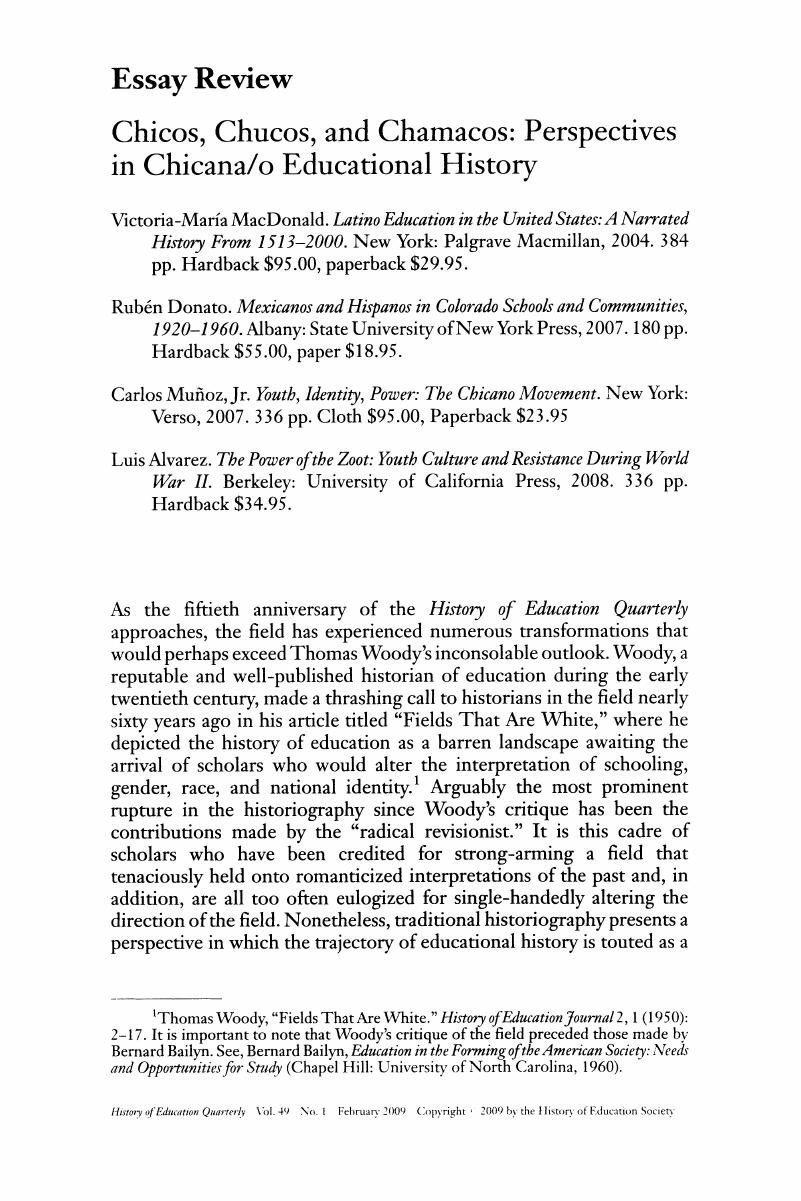No CrossRef data available.
Article contents
Chicos, Chucos, and Chamacos: Perspectives in Chicana/o Educational History
Published online by Cambridge University Press: 24 February 2017
Abstract

- Type
- Essay Review
- Information
- Copyright
- Copyright © 2009 History of Education Society
References
1 Woody, Thomas, “Fields That Are White.” History of Education Journal 2, 1 (1950): 2–17. It is important to note that Woody's critique of the field preceded those made by Bernard Bailyn. See, Bailyn, Bernard, Education in the Forming of the American Society: Needs and Opportunities for Study (Chapel Hill: University of North Carolina, 1960).Google Scholar
2 See, for example, De León, Marcos, “Wanted: A New Educational Philosophy for the Mexican-American.” California Journal of Secondary Education 34, 7 (1959), 398–402, Gomez-Qui$nTones, Juan, “To Leave to Hope or Chance: Propositions on Chicano Studies, 1974,” in Parameters of Institutional Change: Chicano Experiences in Education, ed. Study Commission on Undergraduate Education and the Education of Teachers. Southwest Network for Chicanos (Hayward, CA: Southwest Network, (1974), 53–166, Hernandez, Deluvina, Mexican American Challenge to a Sacred Cow (Los Angeles: UCLA Mexican American Cultural Center, 1970), Sanchez, George I., “Spanish-Speaking People in the Southwest: A Brief Historical Review.” California Journal of Elementary Education 22, 2 (1953), 106–111.Google Scholar
3 For examples of important documentary histories, see Hofstadter, Richard and Smith, Wilson, American Higher Education: A Documentary History (Chicago: University of Chicago Press, 1961), Lazerson, Marvin and Grubb, W. Norton, American Education and Vocationalism: A Documentary History, 1870–1970 (New York: Teachers College Press, 1974), Moquin, Wayne and Charles Lincoln Van Doren, A Documentary History of the Mexican Americans (New York: Praeger, 1971).Google Scholar
4 For example, see Rhoads, Robert A., Freedom's Web: Student Activism in an Age of Cultural Diversity (Baltimore: Johns Hopkins University Press, 1998).Google Scholar
5 In the second edition of Karier's book, he made it clear that he was modifying his approach to be more sympathetic to issues of race and gender. The results are debatable, nonetheless. See, Clarence J. Karier, The Individual, Society, and Education: A History of American Educational Ideas (Urbana: University of Illinois Press, 1986), Karier, Clarence J., Man, Society, and Education: A History of American Educational Ideas (Glenview, IL: Scott, Foresman, 1967).Google Scholar
6 For a brief look on the relationship between schooling, zoot suits, and race see Mu$nToz's discussion on p. 135.Google Scholar
7 For a helpful discussion on consumerism and the history of dress, see Cook, Daniel Thomas, The Commodification of Childhood: The Children's Clothing Industry and the Rise of the Child Consumer (Durham: Duke University Press, 2004). For a useful discussion of recent forms of cultural performance, see Hutchinson, Sydney, From Quebradita to Duranguense: Dance in Mexican American Youth Culture (Tucson: University of Arizona Press, 2007).Google Scholar
8 For innovative studies on youth and children, see Chávez-García, Miroslava, “Youth, Evidence, and Agency: Mexican and Mexican American Youth at the Whittier State School, 1890–1920.” Aztlan 31, 2 (2006), 25–83, Limón, José E., “History, Chicano Joking, and the Varieties of Higher Education: Tradition and Performance as Critical Symbolic Action.” Journal of the Folklore Institute 19, 2/3 (1982), 141–166, Macías, Anthony, “Rock Con Raza, Raza Con Jazz: Latino/os and Post-World War II Popular American Music,” in Musical Migrations: Transnationalism and Cultural Hybridity in Latin/o America, ed. Aparicio, Frances R. and Jáquez, Cándida F. (New York: Palgrave Macmillan, 2003), 183–197, Douglas, Monroy, “Our Children Get So Different Here: Film, Fashion, Popular Culture and the Process of Cultural Syncretization in Mexican Los Angeles, 1900–1935.” Aztlan 19, no. 1 (1990), 79–108, Wild, Mark, “Members of Many Gangs: Childhood and Ethno-Racial Identity on the Streets of Twentieth-Century Urban America,” in Immigrant Life in the U.S.: Multi-Disciplinary Perspectives, ed. Gabaccia, Donna R. and Leach, Colin Wayne (London: Routledge, 2004), 99–112. All of these studies, however, focus on California.Google Scholar
9 For relevant studies on gender, see Espinoza, Dionne, “'Tanto Tiempo Disfrutamos': Chicanas and the Sexual Politics of Chicano Youth Culture in Los Angeles in the 1960s,” in Velvet Barrios: Chicano Popular Culture and Sexualities, ed. Alicia Gaspar de Alba (New York: Palgrave Macmillan, 2003), 89–106, Leyva, Yolanda Chávez, “Cruzando La Linea: Engendering the History of Border Mexican Children During the Early Twentieth Century,” in Memories and Migrations: Mapping Boricua and Chicana Histories, ed. Ruiz, Vicki L. and Chavez, John R. (Urbana: University of Illinois Press, 2008), 71–92, Ruíz, Vicki L., “The Flapper and the Chaperone: Historical Memory among Mexican-American Women,” in Seeking Common Ground: Multidisciplinary Studies of Immigrant Women in the United States, ed. Gabaccia, Donna R. (Westport, CT: Greenwood Publishing Group, 1992), 141–157.Google Scholar




